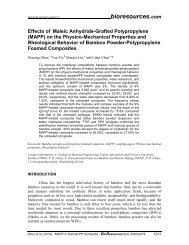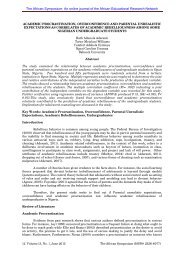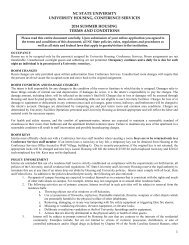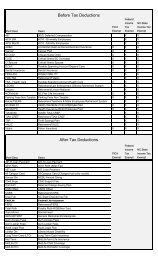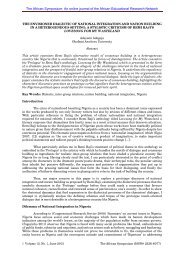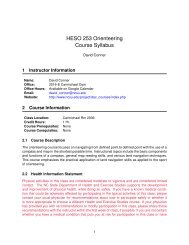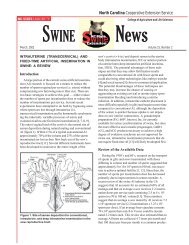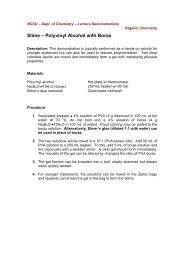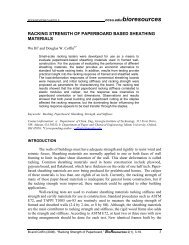Putz et al. 2000 - North Carolina State University
Putz et al. 2000 - North Carolina State University
Putz et al. 2000 - North Carolina State University
You also want an ePaper? Increase the reach of your titles
YUMPU automatically turns print PDFs into web optimized ePapers that Google loves.
Essay<br />
Why Poor Logging Practices Persist in the Tropics<br />
FRANCIS E. PUTZ,*§ DENNIS P. DYKSTRA,† AND RUDOLF HEINRICH‡<br />
*Center for Internation<strong>al</strong> Forestry Research, P.O. Box 6596 JKPWB, Jakarta 10065, Indonesia<br />
†World Forestry Center, 4033 SW Canyon Road, Portland, OR 97221, U.S.A.<br />
‡Forestry Department, Food and Agriculture Organization, Vi<strong>al</strong>e Terme di Carac<strong>al</strong>la 00100, Rome, It<strong>al</strong>y<br />
Abstract: Despite abundant evidence that both the environment<strong>al</strong> damage and the financi<strong>al</strong> costs of logging<br />
can be reduced substanti<strong>al</strong>ly by training workers, pre-planning skid trails, practicing direction<strong>al</strong> felling, and<br />
carrying out a vari<strong>et</strong>y of other well-known forestry practices, destructive logging is still common in the tropics.<br />
Based on our collective experience with loggers in tropic<strong>al</strong> forests, we discuss seven possible reasons for<br />
this seemingly irration<strong>al</strong> behavior. The princip<strong>al</strong> reason poor logging practices persist is apparently that the<br />
widely her<strong>al</strong>ded cost savings associated with reduced-impact logging relative to unplanned logging by untrained<br />
crews may not be re<strong>al</strong>ized under some conditions. In particular, where compliance with logging<br />
guidelines restricts access to steep slopes or prohibits ground-based timber yarding on w<strong>et</strong> ground, reducedimpact<br />
logging may be synonymous with reduced-income logging. Given that under such conditions loggers<br />
may not adopt reduced-impact logging m<strong>et</strong>hods out of self-interest, fisc<strong>al</strong> mechanisms for promoting sustainable<br />
forest management may be needed.<br />
Porque Persisten las Prácticas Madereras Deficientes en los Trópicos<br />
Resumen: A pesar de las abundantes evidencias que muestran que tanto el daño ambient<strong>al</strong>, como el costo<br />
financiero de la t<strong>al</strong>a pueden ser sustanci<strong>al</strong>mente reducidos mediante el entrenamiento de trabajadores, la<br />
planeación anticipada de senderos de arrastre, la t<strong>al</strong>a direccion<strong>al</strong> y una gran variedad de prácticas forest<strong>al</strong>es<br />
bien conocidas, la t<strong>al</strong>a destructiva es aún común en los trópicos. En base a la experiencia colectiva de los autores<br />
con t<strong>al</strong>adores en bosques tropic<strong>al</strong>es, parecen existir si<strong>et</strong>e razones por las cu<strong>al</strong>es sucede esta aparentemente<br />
irracion<strong>al</strong> conducta. Supuestamente la razón princip<strong>al</strong> por la cu<strong>al</strong> las prácticas deficientes de t<strong>al</strong>a persisten<br />
se debe a que el ampliamente anunciado ahorro en el costo de la cosecha asociado con la t<strong>al</strong>a de<br />
impacto reducido, relativo a la t<strong>al</strong>a sin planeación por grupos de trabajo sin entrenamiento podría no ocurrir<br />
bajo ciertas condiciones. En particular, en situaciones donde el seguimiento de las guías de t<strong>al</strong>a restringen<br />
el acceso a pendientes pronunciadas o prohiben el arrastre de los troncos sobre suelo mojado, la t<strong>al</strong>a de<br />
impacto reducido podría ser sinónimo de t<strong>al</strong>a de ganancia reducida. Dado que bajo estas condiciones los t<strong>al</strong>adores<br />
podrían no adoptar los métodos de t<strong>al</strong>a de impacto reducido en base a un puro interés person<strong>al</strong>, se<br />
necesita de mecanismos fisc<strong>al</strong>es para promover el manejo sustentable de los bosques.<br />
Introduction<br />
Although foresters have been recommending implementation<br />
of m<strong>et</strong>hods to reduce the effects of logging for decades<br />
(e.g., Bryant 1914; Nicholson 1958; Redhead<br />
1960; Ewel & Conde 1980; Hendrison 1990; Heinrich<br />
§<br />
Current address: Department of Botany, <strong>University</strong> of Florida,<br />
Gainesville, FL 32611, U.S.A., email fep@botany.ufl.edu<br />
Paper submitted March 11, 1999, revised manuscript accepted December<br />
24, 1999.<br />
1995; Haworth 1999), good logging practices are still<br />
the exception rather than the rule in most of the tropics.<br />
Even the most ardent critics of natur<strong>al</strong> forest management<br />
as a conservation strategy in the tropics (e.g., Rice<br />
<strong>et</strong> <strong>al</strong>. 1997; Bowles <strong>et</strong> <strong>al</strong>. 1998; Frumhoff & Losos 1998)<br />
advocate application of reduced-impact m<strong>et</strong>hods when<br />
and where logging does occurs. We address the question<br />
of why, after nearly a century of extolling the virtues<br />
of reduced-impact logging practices, poor logging<br />
practices persist in the tropics (e.g., Poore <strong>et</strong> <strong>al</strong>. 1989;<br />
Johnson & Cabarle 1993). We present the litany of rea-<br />
Conservation Biology, Pages 951–956<br />
Volume 14, No. 4, August <strong>2000</strong><br />
951
952<br />
Logging in the Tropics <strong>Putz</strong> <strong>et</strong> <strong>al</strong>.<br />
sons given to us for poor logging over our collective 80<br />
years of experience in tropic<strong>al</strong> forest management, research,<br />
and training. The potenti<strong>al</strong> biases of this subjective<br />
m<strong>et</strong>hod cannot be denied, and we do not claim that<br />
our list of excuses is compl<strong>et</strong>e, but we hope that our impressions<br />
will clarify this critic<strong>al</strong> issue.<br />
By reduced-impact logging (RIL), we mean implementation<br />
of a series of pre- and postlogging guidelines designed<br />
to protect advanced regeneration (i.e., seedlings,<br />
saplings, poles, and sm<strong>al</strong>l trees) from injury; to minimize<br />
soil damage; to prevent unnecessary damage to nontarg<strong>et</strong><br />
species (e.g., wildlife and nontimber forest products);<br />
and to protect critic<strong>al</strong> ecosystem processes (e.g.,<br />
hydrology and carbon sequestration). Most RIL guidelines<br />
c<strong>al</strong>l for at least the following measures: pre-harvest<br />
planning of the routes of skid trails and the locations of<br />
log yards; direction<strong>al</strong> felling to facilitate timber yarding<br />
and to protect potenti<strong>al</strong> crop trees; restrictions on movements<br />
of ground-based yarding equipment on steep<br />
slopes and during w<strong>et</strong> weather; and post-logging closure<br />
operations to drain roads and skid trails and to remove<br />
potenti<strong>al</strong> impediments to stream flow. Training and supervision<br />
of logging crews are viewed as critic<strong>al</strong> for reducing<br />
the del<strong>et</strong>erious effects of logging (Pinard <strong>et</strong> <strong>al</strong>.<br />
1995). Rather than discuss these guidelines and their implementation<br />
in more d<strong>et</strong>ail here, we refer readers to<br />
the Model Code of Forest Harvesting Practices recently<br />
published by the Food and Agriculture Organization<br />
(Dykstra & Heinrich 1996) and to other similar s<strong>et</strong>s of<br />
harvesting guidelines (e.g., Marn & Jonkers 1981; de<br />
Graaf 1986; Pinard <strong>et</strong> <strong>al</strong>. 1995; Bertault & Sist 1997; Amar<strong>al</strong><br />
<strong>et</strong> <strong>al</strong>. 1998). Where RIL techniques have been employed<br />
during logging of lowland tropic<strong>al</strong> forests, the<br />
amount of damage to advanced regeneration and soils<br />
has gener<strong>al</strong>ly been reduced by about 50% relative to<br />
convention<strong>al</strong> logging (e.g., Johns <strong>et</strong> <strong>al</strong>. 1996; Pinard &<br />
<strong>Putz</strong> 1996; Elias 1997; Winkler 1997). Employing RIL<br />
techniques is not equiv<strong>al</strong>ent to sustainable forest management<br />
but, in many forests it would constitute a substanti<strong>al</strong><br />
step toward this cov<strong>et</strong>ed go<strong>al</strong> (e.g., <strong>Putz</strong> 1994).<br />
When asked why they do not employ RIL techniques,<br />
commerci<strong>al</strong> loggers give answers that, in our opinion,<br />
vary greatly in their justifiability. This paper is organized<br />
around six of the most common reasons or excuses<br />
given to us for poor logging, with emphasis on groundbased<br />
yarding techniques. We address the most common<br />
reason we have heard—that RIL is too expensive—<br />
in substanti<strong>al</strong> d<strong>et</strong>ail. We add a seventh reason that concerns<br />
us but that we have not y<strong>et</strong> heard explicitly mentioned<br />
by loggers.<br />
Reason 1: RIL Is too Expensive<br />
Researchers in Sarawak (Marn & Jonkers 1981), Sabah<br />
(M<strong>al</strong>vas 1987), Suriname (de Graaf 1986; Jonkers 1987;<br />
Conservation Biology<br />
Volume 14, No. 4, August <strong>2000</strong><br />
Hendrison 1990), and Brazil (Barr<strong>et</strong>o <strong>et</strong> <strong>al</strong>. 1998; Boltz<br />
1999) provide evidence that RIL is less expensive per<br />
unit volume of timber yarded to the roadside than convention<strong>al</strong>,<br />
unplanned logging. The immediate financi<strong>al</strong><br />
benefits of RIL derive mostly from the high costs of fueling<br />
and maintaining bulldozers and rubber-tired skidders<br />
(henceforth referred to collectively as “skidders”) relative<br />
to labor costs for planning and supervision. Lost<br />
logs, avoidable damage to the boles of felled trees, and<br />
inefficient bucking (cutting logs into merchantable<br />
lengths) account for addition<strong>al</strong> savings when RIL techniques<br />
are applied (Gerwing <strong>et</strong> <strong>al</strong>. 1996; Bertault & Sist<br />
1997).<br />
Why have loggers gener<strong>al</strong>ly disregarded the repeatedly<br />
demonstrated benefits of RIL? Perhaps the primary<br />
financi<strong>al</strong> beneficiaries of the expected RIL savings are<br />
not the same people who decide wh<strong>et</strong>her or not RIL<br />
m<strong>et</strong>hods are to be used. Or, perhaps the actu<strong>al</strong> cost savings<br />
of RIL are less than those c<strong>al</strong>culated from sm<strong>al</strong>lsc<strong>al</strong>e<br />
research plots when derived under typic<strong>al</strong> industri<strong>al</strong><br />
logging conditions and at the sc<strong>al</strong>es at which most<br />
commerci<strong>al</strong> loggers operate. In other words, there may<br />
be a defensible basis for the claim by some loggers that<br />
RIL more appropriately should stand for reduced-income<br />
logging.<br />
In most large-sc<strong>al</strong>e tropic<strong>al</strong> logging operations, fellers<br />
and skidder drivers are paid on the basis of the volume<br />
of timber yarded to log landings. Because skidder drivers<br />
gener<strong>al</strong>ly do not pay for their own fuel, the benefits of<br />
increased fuel efficiency derived from using pre-planned<br />
skid trails accrue to the logging contractor. From the<br />
perspective of timber fellers, RIL training reduces the<br />
risks of injury, but w<strong>et</strong>-weather shutdowns reduce<br />
wages. On the other hand, decreased log breakage during<br />
felling and decreased likelihood of losing logs benefits<br />
fellers and skidder drivers as well as forest owners<br />
and concession holders.<br />
The financi<strong>al</strong> benefits of RIL for logging contractors<br />
may be reduced when trained forest workers demand<br />
higher wages and some other benefits (e.g., insurance,<br />
saf<strong>et</strong>y equipment, <strong>et</strong>c.; Cedergren 1996). Furthermore,<br />
if logging crews racing to beat inclement weather or for<br />
some other reason feel pressure to log quickly, RIL planning<br />
is benefici<strong>al</strong> only if it does not entail work slowdowns<br />
while stock maps are drawn, felling directions<br />
are d<strong>et</strong>ermined and indicated, and skid trails are planned.<br />
Mill owners with delivery schedules to me<strong>et</strong> and mill<br />
workers to pay (wh<strong>et</strong>her or not there are logs to process)<br />
are likely to be concerned about any changes in<br />
logging operations that slow or interrupt log deliveries<br />
to the mill gate. These complicating issues of perspective<br />
in ev<strong>al</strong>uating the financi<strong>al</strong> benefits of RIL do not pertain<br />
to forest owners or the gener<strong>al</strong> public. Based on the<br />
many environment<strong>al</strong> benefits of RIL compared to convention<strong>al</strong><br />
logging, including the expected increases in<br />
future timber yields when regeneration is protected
<strong>Putz</strong> <strong>et</strong> <strong>al</strong>. Logging in the Tropics<br />
from logging damage, forest owners and the public have<br />
every reason to support RIL. The exception to this gener<strong>al</strong><br />
conclusion might be forest owners with insecure<br />
tenure or other reasons to discount the v<strong>al</strong>ue of future<br />
harvests (e.g., Boscolo & Vincent 1998).<br />
Some of the differences b<strong>et</strong>ween RIL and convention<strong>al</strong><br />
logging are likely to be greater on level ground<br />
than on steep terrain. When convention<strong>al</strong> selective logging<br />
is conducted on moderately level ground, skidder<br />
drivers seem prone to search for logs while creating an<br />
ever-increasing density of skid trails. In contrast, when<br />
yarding is conducted on steep slopes, fewer viable paths<br />
are available to even the most environment<strong>al</strong>ly unconcerned<br />
skidder drivers. This constraint may explain why<br />
in Sabah, M<strong>al</strong>aysia, <strong>al</strong>though the proportion of soil disturbed<br />
by bulldozers during a large-sc<strong>al</strong>e RIL experiment<br />
was reduced by 50% compared to areas subjected to<br />
convention<strong>al</strong> logging (Pinard <strong>et</strong> <strong>al</strong>. 1999), convention<strong>al</strong><br />
logging disturbed only 19% of the soil surface rather<br />
than the 40–50% observed in other logging areas (Sabah<br />
Forest Department 1989). Similarly, the need to reinforce<br />
extraction paths with felled trees when logging<br />
swamp forests might <strong>al</strong>so dissuade skidder drivers from<br />
disturbing a high proportion of the area (Brown 1955;<br />
Webb 1997).<br />
Although skidder drivers in convention<strong>al</strong>ly logged<br />
areas often yard logs from precipitous terrain, RIL guidelines<br />
for such slopes gener<strong>al</strong>ly c<strong>al</strong>l for timber yarding<br />
techniques in which logs are suspended off the ground.<br />
Although the direct financi<strong>al</strong> costs of ground-based yarding<br />
increase with increasing slope, skyline yarding is reportedly<br />
somewhat more expensive, and helicopter yarding<br />
is much more expensive per unit volume of timber<br />
harvested (Aulerich <strong>et</strong> <strong>al</strong>. 1975; Conway 1982). Where<br />
aeri<strong>al</strong> yarding technologies are not readily available, loggers<br />
constrained to ground-based yarding who consider<br />
adoption of RIL techniques may b<strong>al</strong>k at the volume of<br />
timber to be foregone on steep slopes. Furthermore,<br />
some forest owners may object to the reduced profits resulting<br />
from foregoing harvesting on adverse terrain<br />
(Tay 1999). Similar resistance to the introduction of<br />
aeri<strong>al</strong> yarding techniques has been successfully overcome<br />
in many temperate forests where forest-cutting<br />
practices are controlled by the state (Conway 1982).<br />
Because of decreasing soil trafficability with increasing<br />
moisture content (e.g., Greacen & Sands 1980), RIL<br />
guidelines gener<strong>al</strong>ly restrict ground-based yarding during<br />
w<strong>et</strong> weather. Where logging operations are norm<strong>al</strong>ly<br />
shut down for the rainy season, as in many tropic<strong>al</strong> forests,<br />
this restriction is not problematic (DeBonis 1986).<br />
In contrast, where rainf<strong>al</strong>l season<strong>al</strong>ity is not pronounced<br />
or the rainy season is long, logging typic<strong>al</strong>ly continues<br />
on saturated soil. Despite the environment<strong>al</strong> damage<br />
and somewhat higher yarding and hauling costs, loggers<br />
may not want to suspend their operations when the soil<br />
is w<strong>et</strong>. C<strong>al</strong>culations of the financi<strong>al</strong> consequences of<br />
Conservation Biology<br />
Volume 14, No. 4, August <strong>2000</strong><br />
953<br />
such temporary and unscheduled shutdowns need to include<br />
both labor costs and the less obvious costs of disrupting<br />
deliveries of logs to mills. On the positive side of<br />
the equation are the reduced road maintenance costs<br />
where hauling is h<strong>al</strong>ted during w<strong>et</strong> weather.<br />
Even if the strict financi<strong>al</strong> costs of felling and yarding<br />
timber to a roadside increase when operations are<br />
planned and carried out by trained and supervised workers,<br />
the long-term costs to the forest owner of uncontrolled<br />
logging are gener<strong>al</strong>ly excessive. Furthermore, if<br />
the costs of regenerating stands after logging are included<br />
in the comparison of RIL and convention<strong>al</strong> logging,<br />
then RIL is certainly cost-effective. Adding in the<br />
v<strong>al</strong>ues derived from protecting soils, biodiversity, and<br />
ecosystem functions makes uncontrolled logging economic<strong>al</strong>ly<br />
absurd. Nevertheless, parti<strong>al</strong>ly because loggers<br />
are seldom forest owners, long-term forest management<br />
plans that are actu<strong>al</strong>ly followed remain som<strong>et</strong>hing<br />
of a rarity in the tropics.<br />
Reason 2: There’s Nothing Wrong with Current<br />
Logging Practices<br />
As long as there are rich primary forests in the tropics to<br />
exploit, and as long as rent-capture mechanisms of forest<br />
owners remain weak (e.g., Gillis 1992), logging profits<br />
are likely to remain high or excessive (e.g., Veríssimo<br />
<strong>et</strong> <strong>al</strong>. 1992). With high profits, many loggers will be unlikely<br />
to admit that anything is wrong with convention<strong>al</strong><br />
practices and to voluntarily adopt RIL m<strong>et</strong>hods. Forest<br />
ownership or the securing of long-term and tradable<br />
concessions may increase the likelihood of forest exploiters<br />
becoming forest managers, but it is nevertheless<br />
difficult to wean individu<strong>al</strong>s and governments from fantastic<br />
short-term profits.<br />
Lately there has been no shortage of diatribes against<br />
tropic<strong>al</strong> forestry (e.g., Rice <strong>et</strong> <strong>al</strong>. 1997; Struhsaker 1997;<br />
Bowles <strong>et</strong> <strong>al</strong>. 1998), but perhaps the critic<strong>al</strong> information<br />
about damage to the resource base caused by uncontrolled<br />
logging and the benefits of RIL techniques are<br />
not reaching the right people. Many researchers publish<br />
their results in internation<strong>al</strong> scientific journ<strong>al</strong>s (such as<br />
this one) and otherwise try to disseminate their findings,<br />
but for various reasons the message is not g<strong>et</strong>ting<br />
through or having the desired effect. We hope the logging<br />
industry will respond to the more truly collaborative,<br />
industri<strong>al</strong>-sc<strong>al</strong>e demonstrations of RIL now underway<br />
in many parts of the tropics (e.g., Elias 1997;<br />
Winkler 1997). Above <strong>al</strong>l, it is clear to us that everyone<br />
interested in maintaining he<strong>al</strong>thy forests and forest industries<br />
needs to do everything possible to g<strong>et</strong> the word<br />
out that in many places there is indeed a great de<strong>al</strong><br />
wrong with current logging practices and that environment<strong>al</strong>ly<br />
sound <strong>al</strong>ternatives are available.
954<br />
Logging in the Tropics <strong>Putz</strong> <strong>et</strong> <strong>al</strong>.<br />
Reason 3: Lack of Government<strong>al</strong> Incentives to<br />
Change Logging Practices<br />
We would accept this excuse for not adopting RIL m<strong>et</strong>hods<br />
if the words “that cannot be disregarded or circumvented”<br />
were added after the word “incentives.<br />
” Most<br />
countries in the tropics have laws and regulations that<br />
dis<strong>al</strong>low many of the most familiar poor logging practices<br />
(e.g., Hardaway <strong>et</strong> <strong>al</strong>. 1994). Unfortunately, command-and-control<br />
approaches to changing forestry practices<br />
have had little effect in most parts of the tropics,<br />
where institution<strong>al</strong> failure is common (P<strong>al</strong>mer & Synnott<br />
1992; Barr<strong>et</strong>o <strong>et</strong> <strong>al</strong>. 1998). The new forestry laws in Bolivia<br />
and Costa Rica which provide tax incentives for forest<br />
protection and environment<strong>al</strong>ly sound forest management<br />
are promising but not y<strong>et</strong> fully tested attempts<br />
to change forest-use practices. Perhaps the various internation<strong>al</strong><br />
agreements pertaining to forests, such as the<br />
Glob<strong>al</strong> Convention on Climate Change, will support<br />
these and other nation<strong>al</strong> efforts to prevent forest degradation<br />
(Amilen 1997), but this remains to be seen.<br />
Positive incentives for b<strong>et</strong>ter forest management, such<br />
as certification (e.g., Viana <strong>et</strong> <strong>al</strong>. 1996) and RIL-based<br />
carbon offs<strong>et</strong>s (e.g., <strong>Putz</strong> & Pinard 1993), <strong>al</strong>so seem<br />
promising but have not y<strong>et</strong> had a large effect on the industry.<br />
Again, mark<strong>et</strong>-based incentives are unlikely to be<br />
influenti<strong>al</strong> as long as profits are excessive, because timber<br />
is essenti<strong>al</strong>ly being mined from primary forests, and<br />
governments capture only a portion of the relatively<br />
modest rents due (e.g., Rep<strong>et</strong>to & Gillis 1988). Following<br />
this logic, perhaps the recent surge of third-party forest<br />
certification activity in Bolivia (in which about 1 million<br />
ha of forest is certified as well managed by the<br />
Forest Stewardship Council) was motivated by the high<br />
costs of hauling wood products over the Andes, lack of<br />
good roads to logging areas, and low harvestable volumes<br />
of commerci<strong>al</strong> timber due to previous exploitation<br />
and wildfires.<br />
Reason 4: The Forest Will Be Converted Anyway<br />
Deforestation for agriculture continues in much of the<br />
tropics by both planned means (e.g., for oil p<strong>al</strong>m and<br />
pulpwood plantation establishment) and unplanned means<br />
(e.g., by spontaneous colonization). In areas destined for<br />
conversion, it is understandable that loggers make no<br />
effort to protect advanced regeneration and potenti<strong>al</strong><br />
crop trees. In contrast, damage to soil and hydrologic<strong>al</strong><br />
processes, two common consequences of uncontrolled<br />
logging, cannot be justified under any circumstances.<br />
Furthermore, unnecessarily damaging the resource base<br />
through poor logging practices increases the likelihood<br />
of unplanned deforestation by decreasing the future<br />
Conservation Biology<br />
Volume 14, No. 4, August <strong>2000</strong><br />
profitability of forestry compared with other, nonforest<br />
land uses (e.g., Dickinson <strong>et</strong> <strong>al</strong>. 1996).<br />
Reason 5: Available Equipment Is Unsuitable<br />
for RIL<br />
Although speci<strong>al</strong> tools can contribute to reducing the<br />
del<strong>et</strong>erious environment<strong>al</strong> effects of logging (e.g., skyline<br />
yarding systems; Sessions & Heinrich 1993), substanti<strong>al</strong><br />
reductions in damage through use of existing<br />
equipment have been demonstrated repeatedly (e.g., Pinard<br />
<strong>et</strong> <strong>al</strong>. 1995; Barr<strong>et</strong>o <strong>et</strong> <strong>al</strong>. 1998; Sist <strong>et</strong> <strong>al</strong>. 1998).<br />
Nevertheless, there are some sites where ground-based<br />
yarding is not possible without causing excessive environment<strong>al</strong><br />
damage (e.g., on steep slopes), and there are<br />
some conditions under which yarding operations should<br />
be postponed (e.g., when soils are saturated). Fortunately,<br />
direction<strong>al</strong> felling to protect future crop trees<br />
and to facilitate yarding, the use of pre-harvest planning<br />
of skid trails, and the use of skidder-mounted winches to<br />
reduce soil damage are components of RIL that can be<br />
implemented with standard equipment.<br />
Reason 6: Lack of Training and Guidance by<br />
RIL Experts<br />
To improve worker saf<strong>et</strong>y and to reduce logging damage,<br />
the need for training in logging operations cannot<br />
be over-stressed. According to the Internation<strong>al</strong> Labour<br />
Organization (1990), tropic<strong>al</strong> forest logging is among the<br />
world’s most dangerous occupations (e.g., 5–10 reported<br />
fat<strong>al</strong>ities per million cubic m<strong>et</strong>ers harvested in Sarawak,<br />
M<strong>al</strong>aysia, during the 1976–1989 period). More training<br />
programs are needed for both workers and managers,<br />
but both groups need first to be motivated to improve<br />
their m<strong>et</strong>hods. When demand for more RIL training becomes<br />
apparent, we implore nation<strong>al</strong> and internation<strong>al</strong><br />
organizations to ensure that it is provided.<br />
As researchers and trainers concerned with tropic<strong>al</strong><br />
forest management, we take to heart the claim that forest<br />
managers are not given enough guidance from RIL<br />
experts. Apparently, new and improved modes of dissemination<br />
of knowledge about RIL need to be developed<br />
and implemented. For example, <strong>al</strong>though there is<br />
no substitute for hands-on training, training videos and<br />
brochures about RIL techniques should be readily available.<br />
The targ<strong>et</strong> audience must include workers, managers,<br />
and decisionmakers from both private and public<br />
sectors. If forest owners were fully cognizant of the<br />
damage being done to their otherwise renewable resources<br />
and were aware of how easily this damage could<br />
be reduced, perhaps they would not be so complacent.
<strong>Putz</strong> <strong>et</strong> <strong>al</strong>. Logging in the Tropics<br />
Reason 7: Lack of Focused Pressure for B<strong>et</strong>ter<br />
Logging from Environment<strong>al</strong> Groups<br />
Many people are not familiar with proper forest management<br />
practices. Stark scenes of huge clearcuts are so<br />
haunting that it is difficult for many to distinguish b<strong>et</strong>ween<br />
good and bad logging practices. In the dozens of<br />
articles published on the effects of logging on wildlife in<br />
the tropics (for recent reviews, see Grieser Johns 1997;<br />
Fimbel <strong>et</strong> <strong>al</strong>. <strong>2000</strong>), only one study was carried out in a<br />
forest from which timber was harvested according to<br />
RIL guidelines (Crome 1996). Instead of lobbying for<br />
b<strong>et</strong>ter forest-management practices, <strong>North</strong>ern environment<strong>al</strong>ists<br />
only repeat the familiar r<strong>al</strong>lying cry to stop<br />
logging and establish more nation<strong>al</strong> parks in the tropics<br />
(e.g., Dickinson <strong>et</strong> <strong>al</strong>. 1996; Rice <strong>et</strong> <strong>al</strong>. 1997; Bowles <strong>et</strong> <strong>al</strong><br />
1998). There are nevertheless continuing efforts to shift<br />
attention from even more d<strong>et</strong>ail on the del<strong>et</strong>erious effects<br />
of uncontrolled logging to solutions to the problem<br />
of how to manage tropic<strong>al</strong> forests without causing unacceptable<br />
environment<strong>al</strong> damage (e.g., Uhl <strong>et</strong> <strong>al</strong>.1997).<br />
Conclusion<br />
The long-term benefits of changing from unmitigated<br />
forest exploitation for timber to forest resource (sensu<br />
latu) management will be re<strong>al</strong>ized by everyone, including<br />
the forest industry. Increasing communication b<strong>et</strong>ween<br />
loggers, concession holders, forest owners, forest<br />
researchers, environment<strong>al</strong>ists, and policymakers will<br />
further the cause of reducing the del<strong>et</strong>erious environment<strong>al</strong><br />
effects of uncontrolled logging. Widespread adoption<br />
of RIL might nevertheless require financi<strong>al</strong> incentives<br />
such as those that could be provided in the name<br />
of enhanced carbon sequestration in forests logged carefully<br />
relative to that in forests subjected to convention<strong>al</strong><br />
logging (e.g., Brown 1998; Stuart and Moura-Costa<br />
1998). Well-managed forests can provide income as well<br />
as many of the forest resources and ecosystem services<br />
that soci<strong>et</strong>y increasingly demands, but what is required<br />
is nothing less than a cultur<strong>al</strong> change from timber mining<br />
to forest management.<br />
Acknowledgments<br />
We thank the innumerable forest workers, logging contractors,<br />
and concessionaires that willingly shared with<br />
us their experiences and explained to us the constraints<br />
under which they operate. Speci<strong>al</strong> thanks go to C.<br />
Romero, G. Blate, J. Smith, and M. Pinard for providing<br />
useful comments on earlier drafts of this manuscript.<br />
Literature Cited<br />
Conservation Biology<br />
Volume 14, No. 4, August <strong>2000</strong><br />
955<br />
Amar<strong>al</strong>, P., A. Verissimo, P. Barr<strong>et</strong>o, and E. Vid<strong>al</strong>. 1998. Floresta para<br />
sempre. Um manu<strong>al</strong> para a produçâo de madeira no Amazônia. Instituto<br />
de Homem e o Ambiente da Amazônia, Belém, Brazil.<br />
Amilen, C. 1997. Are countries liable for their forestry practices? Journ<strong>al</strong><br />
of Forestry 95: 6–9.<br />
Aulerich, D. E., K. N. Johnson, and H. Froehlich. 1975. Tractors or skylines:<br />
what’s best for thining young-growth Douglas-fir. Forest Industries<br />
101: 42–44.<br />
Barr<strong>et</strong>o, P., P. Amar<strong>al</strong>, E. Vid<strong>al</strong>, and C. Uhl. 1998. Costs and benefits of<br />
forest management for timber production in eastern Amazonia.<br />
Forest Ecology and Management 108: 9–26.<br />
Bertault, J. G., and P. Sist. 1997. An experiment<strong>al</strong> comparison of different<br />
harvesting intensities with reduced-impact and convention<strong>al</strong><br />
logging in East K<strong>al</strong>imantan, Indonesia. Forest Ecology and Management<br />
94: 209–218.<br />
Boltz, F. 1999. Bioeconomic r<strong>et</strong>urns under uncertainty for reducedimpact<br />
and convention<strong>al</strong> logging systems in the Brazilian Amazon.<br />
M. S. thesis. <strong>University</strong> of Florida, Gainesville.<br />
Boscolo, M., and J. R. Vincent, 1998. Promoting b<strong>et</strong>ter logging practices<br />
in tropic<strong>al</strong> forests: a simulation an<strong>al</strong>ysis of <strong>al</strong>ternative regulations.<br />
Development discussion paper 652. Harvard <strong>University</strong>, Cambridge,<br />
Massachus<strong>et</strong>ts.<br />
Bowles, I. A., R. E. Rice, R. A. Mittermeier, and G. A. B. da Fonseca. 1998.<br />
Logging and tropic<strong>al</strong> forest conservation. Science 280: 1899–1900.<br />
Brown, G. S. 1955. Timber extraction m<strong>et</strong>hods in <strong>North</strong> Borneo. The<br />
M<strong>al</strong>ayan Forester 18: 121–132.<br />
Brown, P. G. 1998. Toward an economics of stewardship: the case of<br />
climate. Ecologic<strong>al</strong> Economics 26: 11–21.<br />
Bryant, C. D. 1914. Logging. Wiley, New York.<br />
Cedergren, J. 1996. A silvicultur<strong>al</strong> ev<strong>al</strong>uation of stand characteristics,<br />
pre-felling climber cutting and direction<strong>al</strong> felling in a primary<br />
dipterocarp forest in Sabah, M<strong>al</strong>aysia. Ph. D. dissertation. Swedish<br />
<strong>University</strong> of Agricultur<strong>al</strong> Science, Umea.<br />
Conway, S. 1982. Logging practices. Miller Freeman, San Francisco.<br />
Crome, F. H. J. 1996. A novel Bayesian approach to assessing impacts<br />
of rain forest logging. Ecologic<strong>al</strong> Applications 6: 1104–1123.<br />
DeBonis, J. N. 1986. Harvesting tropic<strong>al</strong> forests in Ecuador: w<strong>et</strong><br />
weather shutdowns would benefit industry and environment. Journ<strong>al</strong><br />
of Forestry 84: 43–45.<br />
de Graaf, N. R. 1986. A silvicultur<strong>al</strong> system for natur<strong>al</strong> regeneration of<br />
tropic<strong>al</strong> rain forest in Suriname. Agricultur<strong>al</strong> <strong>University</strong>, Wageningen,<br />
The N<strong>et</strong>herlands.<br />
Dickinson, M. B., J. C. Dickinson, and F. E. <strong>Putz</strong>. 1996. Nation<strong>al</strong> forest management<br />
as a conservation tool in the tropics: divergent views on possibilities<br />
and <strong>al</strong>ternatives. Commonwe<strong>al</strong>th Forestry Review 74: 309–315.<br />
Dykstra, D. P., and R. Heinrich. 1996. FAO model code of forest harvesting<br />
practice. Food and Agricultur<strong>al</strong> Organization, Rome.<br />
Elias. 1997. Reduced impact timber harvesting in the tropic<strong>al</strong> natur<strong>al</strong><br />
forest in Indonesia. Forest harvesting case study 11. Food and Agriculture<br />
Organization, Rome.<br />
Ewel, J., and L. F. Conde. 1980. Potenti<strong>al</strong> ecologic<strong>al</strong> impact of increased<br />
intensity of tropic<strong>al</strong> forest utilization. Biotrop Speci<strong>al</strong> Publication 11.<br />
Fimbel, R. A., A. Graj<strong>al</strong>, and J. G. Robinson. <strong>2000</strong>. Conserving wildlife<br />
in managed tropic<strong>al</strong> forests. Columbia <strong>University</strong> Press, New York.<br />
In press.<br />
Frumhoff, P. C., and E. C. Losos. 1998. S<strong>et</strong>ting priorities for conserving<br />
biologic<strong>al</strong> diversity in tropic<strong>al</strong> timber production forests. Center for<br />
Tropic<strong>al</strong> Forest Science, Smithsonian Institute, Washington, D. C.<br />
Gerwing, J. J., J. S. Johns, and E. Vid<strong>al</strong>. 1996. Reducing waste during<br />
logging and log-processing: forest conservation in eastern Amazonia.<br />
Unasylva 47: 19–25.<br />
Gillis, M. 1992. Forest concession management and revenue policies.<br />
Pages 139-175 in N. P. Sharma, editor. Managing the world’s forests.<br />
Kend<strong>al</strong>l-Hunt, Dubuque, Iowa.
956<br />
Logging in the Tropics <strong>Putz</strong> <strong>et</strong> <strong>al</strong>.<br />
Greacen, E. L., and R. Sands. 1980. Compaction of forest soils: a review.<br />
Austr<strong>al</strong>ian Journ<strong>al</strong> of Soil Research 18: 163–189.<br />
Grieser Johns, A. 1997. Timber production and biodiversity conservation<br />
in tropic<strong>al</strong> rain forests. Cambridge <strong>University</strong> Press, Cambridge,<br />
United Kingdom.<br />
Hardaway, R. M., K. D. Dacres, and J. Swearningen. 1994. Tropic<strong>al</strong> forest<br />
conservation legislation and policy: a glob<strong>al</strong> perspective. Whittier<br />
Law Review 15: 919–953.<br />
Haworth, J. 1999. Life after logging: the impacts of commerci<strong>al</strong> timber<br />
extraction in tropic<strong>al</strong> rainforests. The Rainforest Foundation,<br />
London.<br />
Heinrich, R. 1995. Environment<strong>al</strong>ly sound harvesting to sustain tropic<strong>al</strong><br />
forests. Commonwe<strong>al</strong>th Forestry Review 74: 198–203.<br />
Hendrison, J. 1990. Damage-controlled logging in managed tropic<strong>al</strong><br />
rain forest in Suriname. Agricultur<strong>al</strong> <strong>University</strong>, Wageningen, The<br />
N<strong>et</strong>herlands.<br />
Internation<strong>al</strong> Labour Organization. 1990. Occupation<strong>al</strong> saf<strong>et</strong>y and<br />
he<strong>al</strong>th in forestry. Internation<strong>al</strong> Labour Organization, Geneva, Switzerland.<br />
Johns, J., P. Barr<strong>et</strong>o, and C. Uhl. 1996. Logging damage in planned and<br />
unplanned logging operations and its implications for sustainable<br />
timber production in the eastern Amazon. Forest Ecology and Management<br />
89: 59–77.<br />
Johnson, N., and B. Cabarle. 1993. Surviving the cut: natur<strong>al</strong> forest<br />
management in the humid tropics. World Resources Institute,<br />
Washington, D. C.<br />
Jonkers, W. B. J. 1987. Veg<strong>et</strong>ation structure, logging damage and silviculture<br />
in a tropic<strong>al</strong> rain forest in Suriname. Agricultur<strong>al</strong> <strong>University</strong>,<br />
Wageningen, The N<strong>et</strong>herlands.<br />
M<strong>al</strong>vas, J. D. 1987. A report on the logging demonstration cum training<br />
coupe. Sabah <strong>State</strong> Forest Department, Sandakan, Sabah, M<strong>al</strong>aysia.<br />
Marn, H. M., and W. Jonkers. 1981. Logging damage in tropic<strong>al</strong> high<br />
forest. Working paper 5. Sarawak Forest Department, Kuching, Sarawak,<br />
M<strong>al</strong>aysia.<br />
Nicholson, D. I. 1958. An an<strong>al</strong>ysis of logging damage in tropic<strong>al</strong> rain<br />
forest, <strong>North</strong> Borneo. M<strong>al</strong>ayan Forester 21: 235–245.<br />
P<strong>al</strong>mer, J., and T. Synnott. 1992. The management of natur<strong>al</strong> forests.<br />
Pages 337–373 in N. P. Sharma, editor. Managing the world’s forests.<br />
Kend<strong>al</strong>l-Hunt, Dubuque, Iowa.<br />
Pinard, M. A., and F. E. <strong>Putz</strong>. 1996. R<strong>et</strong>aining forest biomass by reducing<br />
logging damage. Biotropica 28: 278–295.<br />
Pinard, M. A., F. E. <strong>Putz</strong>, J. Tay, and F. E. Sullivan. 1995. Creating timber<br />
harvest guidelines for a reduced-impact logging project in M<strong>al</strong>aysia.<br />
Journ<strong>al</strong> of Forestry 93: 41–45.<br />
Pinard, M. A., M. G. Barker, and J. Tay. 1999. Soil disturbance and postlogging<br />
recovery on bulldozer paths in Sabah, M<strong>al</strong>aysia. Forest Ecology<br />
and Management: in press.<br />
Poore, D., P. Burges, J. P<strong>al</strong>mer, J. Ri<strong>et</strong>bergen, and T. Synnott. 1989. No<br />
Conservation Biology<br />
Volume 14, No. 4, August <strong>2000</strong><br />
timber trees: sustainability in the tropic<strong>al</strong> forest. Earthscan Publications,<br />
London.<br />
<strong>Putz</strong>, F. E. 1994. Towards a sustainable forest. How can forests be managed<br />
in a way that satisfies criteria of sustainability? Internation<strong>al</strong><br />
Tropic<strong>al</strong> Timber Organization Tropic<strong>al</strong> Forestry Update 4: 7–9.<br />
<strong>Putz</strong>, F. E.,and M. A. Pinard. 1993. Reduced-impact logging as a carbonoffs<strong>et</strong><br />
m<strong>et</strong>hod. Conservation Biology 7: 755–757.<br />
Redhead, J. R. 1960. An an<strong>al</strong>ysis of logging damage in lowland rain forest<br />
in western Nigeria. Nigerian Forestry Information Bull<strong>et</strong>in (New<br />
Series) 10: 5–16.<br />
Rep<strong>et</strong>to, R., and M. Gillis, editors. 1988. Public policies and the misuse<br />
of forest resources. Cambridge <strong>University</strong> Press, Cambridge, United<br />
Kingdom.<br />
Rice, R. E., R. E. Gullison, and J. W. Reid. 1997. Can sustainable management<br />
save tropic<strong>al</strong> forest? Scientific American 276: 44–49.<br />
Sabah Forest Department. 1989. Forestry in Sabah. Sandakan, Sabah,<br />
M<strong>al</strong>aysia.<br />
Sessions, J., and R. Heinrich. 1993. Harvesting. Pages 1325–1424 in L.<br />
Pancel, editor. Tropic<strong>al</strong> forestry handbook. Springer-Verlag, Berlin.<br />
Sist, P., T. Nolan, J. G. Bertault, and D. Dykstra. 1998. Harvesting intensity<br />
versus sustainability in Indonesia. Forest Ecology and Management<br />
108: 251–260.<br />
Struhsaker, T. 1997. Ecology of an African forest: logging in Kib<strong>al</strong>e and<br />
the conflict b<strong>et</strong>ween conservation and exploitation. <strong>University</strong><br />
Press of Florida, Gainesville.<br />
Stuart, M. D., and P. Moura-Costa. 1998. Climate change mitigation by<br />
forestry: a review of internation<strong>al</strong> initiatives. Polices that work for<br />
forests and people, series 8. Internation<strong>al</strong> Institute for Environment<br />
and Development, London.<br />
Tay, J. 1999. Economic assessment of reduced impact logging in Sabah,<br />
M<strong>al</strong>aysia. Ph.D. dissertation. <strong>University</strong> of <strong>North</strong> W<strong>al</strong>es, Bangor.<br />
Uhl, C., P. Barr<strong>et</strong>o, A. Veríssimo, E. Vid<strong>al</strong>, P. Amar<strong>al</strong>, A. Barros, C.<br />
Souza Jr., J. Johns, and J. Gerwing. 1997. Natur<strong>al</strong> resource management<br />
in the Brazilian Amazon. BioScience 47: 160–168.<br />
Veríssimo, A., P. Barr<strong>et</strong>o, M. Mattos, R. Tarifa, and C. Uhl. 1992. Logging<br />
impacts and prospects for sustainable forest management in<br />
an old Amazonian frontier: the case of Paragominas. Forest Ecology<br />
and Management 55: 169–199.<br />
Viana, V., J. Ervin, R. Z. Donovan, C. Elliot, and H. Gholz, editors.<br />
1996. Certification of forest products: issues and perspectives. Island<br />
Press, Washington, D.C.<br />
Webb, E. L. 1997. Canopy remov<strong>al</strong> and residu<strong>al</strong> stand damage during<br />
controlled selective logging in lowland swamp forest of northeast<br />
Costa Rica. Forest Ecology and Management 95: 117–129.<br />
Winkler, N. 1997. Environment<strong>al</strong>ly sound forest harvesting: testing the<br />
applicability of the FAO Model Code in the Amazon in Brazil. Forest<br />
harvesting case study 8. Food and Agriculture Organization,<br />
Rome.



